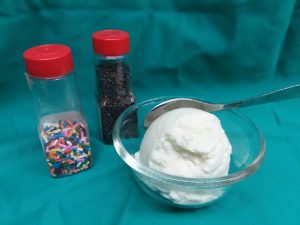
by Claire Davis | Jul 1, 2022
July is one of my favorite months of the year. Summer is in full swing, school is out, temperatures are soaring, and we celebrate Independence Day, as well as my birthday! While all those things are great, my favorite part about the month is celebrating National Ice Cream Month all month long! Who wouldn’t love a cold, sweet treat on a hot, summer day?
Did you know that one 1/2 cup serving of regular ice cream is considered a good source of calcium and phosphorous, containing 10% of the recommended daily value? While ice cream can be part of a balanced diet, its high calorie and fat content are something to consider. Ice cream is good in moderation, something I know I struggle with.

Cold, Delicious, and so many flavors! Photo source: Lyndsey B.
One of my favorite things about ice cream is the options are endless. Not only are there numerous flavors to choose from, but there are other options for how it can be made or served. “Add-ins” such as berries, chocolate sauce, sprinkles, and whipped cream can change how the base ice cream tastes. Some of the most popular flavors, such as vanilla, chocolate, cookie dough, strawberry, butter pecan, etc., do not need any add-ins though.
Types of ice cream also can be broken down into different categories:
- Regular ice cream is a frozen food product made from dairy products with at least 10% milk fat.
- Light ice cream contains at least 50% less fat or 33% fewer calories than regular ice cream.
- Low-fat ice cream contains no more than 3 grams of fat per serving.
- Nonfat ice cream contains less that 0.5 gram of fat per serving.
- Frozen custard, also known as French ice cream, contains a minimum of 10% milk fat as well as 1.4% egg yolk solids.
- Sherbets have a milk fat content only between 1-2%.
- Sorbet, also known as water ices, are similar to sherbet, but do not contain dairy.
- Frozen yogurt has a mixture of dairy ingredients such as milk or nonfat milk that has been cultured, as well as other ingredients for sweetening and flavoring.

Enjoy a scoop of ice cream in honor of National Ice Cream Month.
Photo source: UF/IFAS Northwest District
Since the kids are home from school, I am always looking for activities for them. Check out the recipe and instructions below for how to make your own ice cream in a bag at home!
Ingredients:
- 3 Zip-top bags: 2 quart-size and 1 gallon-size
- ¼ c. cream
- ¼ c. milk
- 1 Tbsp. sugar
- 3/4 tsp. vanilla extract
- 4-5 c. ice
- 1/3 c. salt (rock salt or large granules works the best)
- Toppings of your choice (sprinkles, chocolate syrup, fruits, whipped cream, etc.)
Directions:

A cool and refreshing sweet treat
Photo Source: Angela Hinkle
- Bag it! In a quart Zip-top bag, combine cream, milk, sugar and vanilla. Push out excess air and seal. (Double bag it to avoid spillage)
- Ice it! Add the ice and salt into the gallon zip-top bag. Then place the smaller, sealed bag into the ice.
- Shake it! Seal the bag and shake vigorously, 7 to 10 minutes. Do this until the ice cream has hardened. The more you shake, the quicker it hardens.
- Remove it! Remove the smaller bag from the big bag. Throw the big bag away.
- Top it! Either eat the ice cream out of the bag or spoon it into a bowl. Add your favorite toppings and enjoy!
Source:
https://fsi.colostate.edu/ice-cream/

by Angela Hinkle | Jul 18, 2019
Cold and refreshing on a hot summer day. Official by presidential proclamation. It practically saved my life once. Behold – The Power of Ice Cream.
HISTORY
Some say the Chinese invented ice cream in the first century. Roman emperors are also credited with flavoring ice gathered from mountain tops. Still others say ice cream found its start in the areas of Iran or Ancient Greece. Regardless of its origins, ice cream was often only available to royalty who could afford the resources to make it. Once refrigeration/freezing became affordable, the popularity and availability of ice cream rose considerably. So now, most of us – royalty or not – can enjoy the Power of Ice Cream all year long.
THE 411
- Ice Cream is made with greater than 10% milkfat.
- Gelato is generally made up of 7%-8% fat.
- Soft serve has more air mixed in.
- Frozen Yogurt is usually lower in fat and is often available soft-serve style.
- Sherbet freezes a combination of fruit juice with milk, cream, egg white, or gelatin.
THE 911
Picture it. Moving day. One of the hottest, most humid days of the year. The kind of day that you feel like you’re walking around in really warm soup. Though I’m staying hydrated, after about four hours in, it hits me. I go into a fog and literally start to go down to the ground. Luckily, my dad is pretty quick on his feet for a big Sicilian man. He puts me in the shade and says, “Don’t move!’ To this day, I don’t know how he did it so fast, but within two minutes, he got me the best cold ice cream dessert ever. The world was quickly righted as was I. Though this is NOT normal emergency protocol, it’s my miracle ice cream story and I’m sticking to it.
COOL TIDBITS

A cool and refreshing sweet treat
Photo Source: Angela Hinkle
- The United States leads the way in ice cream consumption, eating or licking or drinking about 48 pints or 23 pounds a year.
- President Ronald Reagan declared July National Ice Cream Month. The third Sunday in July, this year July 21st, is National Ice Cream Day.
- Though boasting 31 flavors, Baskin Robbins’ most popular flavor is vanilla.
- Because acquiring vanilla was so difficult before the mid-1800s, vanilla ice cream was considered quite an exotic treat.
- Sometimes, because nerve endings on the roof of your mouth suddenly get cold from eating ice cream, your brain tells the blood vessels, “Contract!” When they go back to their normal size, blood rushes back in. And ooh, “ice cream headache.” One recommendation to prevent this “brain freeze” is to eat slowly. And a recommendation to stop it is to put your tongue up to the roof of your mouth. Nothing guaranteed – so good luck.
- 15%-20% of Americans say they eat ice cream in bed. For more interesting ice cream trivia, visit foodreference.com
BENEFITS
Though not a particularly nutrient dense food, ice cream does have some health benefits. The area of your brain called the orbitofrontal cortex – or pleasure center – is activated when people are happy. Eating ice cream has been identified with having an immediate “happy” effect on the brain. There is also calcium in ice cream, which is good for building strong bones and teeth. Question – should all your daily calcium come from ice cream? Answer – Um, No. Try to choose more calcium-rich foods that are lower in fat and sugar.
So, in moderation of course, enjoy the Power of Ice Cream!

Cold, Delicious, and so many flavors! Photo source: Lyndsey B.
See Below for two healthier ice cream options. Yum!
MyPlate Sundae
This recipe includes all five food groups.
Layer in a clear glass bowl, mug, or cup so you can see all the colorful layers.
- Dairy – Gelato or frozen yogurt – your choice of flavor
- Vegetable – Frozen sweetened rhubarb or cooked, mashed, and cooled sweet potato
- Fruit – Most any berry works great
- Grain – granola
- Protein – Sprinkle on your favorite nuts
Cool and Creamy Calcium Dreamy
Serves 3
Items needed
1 – gallon heavy-duty ziptop bag
1 – quart heavy-duty ziptop bag
rock salt
ice
Procedure – In the 1 quart bag add the following:
¼ cup pasteurized liquid eggs
1 cup fat-free milk
1 cup fat-free half and half
½ cup sugar
1 teaspoon vanilla flavoring
Zip the top closed. Put the 1-quart bag inside the gallon bag. Pack the gallon bag with ice and ¾ cup of rock salt. Close the top. Work the bag back and forth – rolling over and over or tossing back and forth for 15 minutes. It may help to have potholders or a dish towel to hold the bag, as it will get very cold. Drain the water off and stir your cool and creamy calcium dreamy. Repack the gallon bag with ice and rock salt and roll or toss for five more minutes.
Serve immediately with fresh local fruits and nuts. Enjoy!
For more about the dairy food group see https://www.choosemyplate.gov/dairy

by Heidi Copeland | Jul 11, 2018

Enjoy a scoop of ice cream in honor of National Ice Cream Month.
Photo source: UF/IFAS Northwest District
In 1984, President Ronald Reagan declared July as National Ice Cream Month and the third Sunday in July (July 15, 2018) as National Ice Cream Day! Essentially, the entire month of July is supposed to be celebrated with “appropriate ceremonies and activities” involving ice cream! Ice cream is both nutritious and delicious – eaten in moderation, of course.
However, choosing ice cream can be confusing! Categorically, ice cream is included in the frozen dessert category of the frozen food industry. This category of foods comprises groupings such as regular and low-fat ice cream, frozen yogurt, sherbets, and other frozen sweet treats.
According to the International Dairy Foods Association (IDFA), FUN ice cream facts include:
- Regular ice cream is the most popular category of frozen desserts in the U.S.
- Low-fat ice cream is the second most popular category.
- The United States eats the second largest amount of ice cream per capita.
- The average American consumed 13 pounds of ice cream in 2016.
- Ice cream companies made more than 898 million gallons of regular ice cream in 2015.
- A typical serving size is ½ cup or a scoop about the size of a tennis ball.
What really is ice cream? Real ice cream or ice-cream is a frozen sweet made from dairy products, such as milk and cream, combined with flavorings and sweeteners, such as sugar. American federal labeling standards require ice cream to contain a minimum of 10% milk fat per 1/2 cup serving and 20% total milk solids by weight. A bit of air is slowly added to this slow-stirred mixture while chilling to prevent large ice crystals from forming. A term used in processing commercial ice cream is overrun. Overrun means the liquid dairy mixture, once completely chilled, can have expanded up to double its original volume by the incorporation of air. The addition of air (although not an ingredient on the label) results in a smoothly textured ice cream free from palpable ice crystals or sandiness.
Overrun (air) helps explain the vast price discrepancy between ice cream brands. Typically, the more expensive brands generally use more and better quality ingredients and have less overrun, whereas less expensive ice cream brands tend to use the minimum amounts of ingredients required by law and more overrun. In the U.S., ice cream is sold by volume… hence, the standard serving size of ½ cup.
There are so many variations to the basic ice cream recipe. When egg yolk solids are added to ice cream, the name has to reflect this. “Frozen custard” or “French ice cream” or “French custard ice cream” is ice cream with the added egg yolk.
Premium brand ice creams tend to use a higher than standard ice cream recipe with higher fat content and more expensive, better quality ingredients… and less air.
Ice-milk is no longer made. A 1994 change in rules allows ice milk to be labeled as low-fat ice cream. Low-fat ice cream, by law, must contain 50% or less fat than a similar food. Note that the law says nothing about calories. A light ice cream may be just as high in total calories as ice cream because of the addition of other ingredients.
Frozen yogurt, made from yogurt, is a dairy product, with the addition of various sugars and flavorings. However, yogurt’s reputation for being low in calories is not always accurate and, unlike ice cream, there are no federal standards of any kind for frozen yogurt.
Gelato is a type of soft frozen dessert containing a relatively small amount of air. This makes the product dense, rich, and creamy. Gelato can be made with milk, cream, various sugars, and flavoring such as fresh fruit. In the United States, there is no federal standard definition for gelato set forth by the U.S. Food and Drug Administration.
Are sorbet, sherbet, and sherbert all the same? Despite the fact that the legal definitions of sherbet and sherbert can be used interchangeably, sherbet/sherbert is a frozen fruit and dairy product that contains anywhere from 1-2 percent milk fat from milk or cream and 2-5 percent total milk solids. On the other hand, sorbet generally implies a fruit-based frozen dessert with little to no dairy (but may contain egg white). The term sorbet is an unregulated industry standard. However, the industry wants them free from surface crustation, brittleness, syrup bleeding, and large ice crystals.
Confused yet? The frozen dessert market continues to evolve with novelty-frozen inventions made with nondairy to mimic ice cream. Welcome, delicious dairy-free almond, coconut, cashew and soymilk frozen desserts. Notice, these products are not called ice cream but non-dairy frozen desserts. Nevertheless, they are so smooth, creamy, and delicious, you might not even notice.
In 1984, when President Reagan crafted the amusing proclamation to eat ice cream, folks didn’t have SO much to choose from. You do! Enjoy a frozen treat but know what you are buying. Not all frozen treats are in fact ice cream! When you are reading nutrition labels, it is important to look at the whole picture. You can learn a lot from a label!






